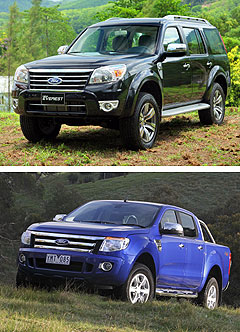Ford set to scale Everest
BY RON HAMMERTON | 29th Dec 2011

The name and possible model line-up was revealed in what might have been an accidental glimpse of web development for its future model on Ford’s Australian consumer website.
Spotted by GoAuto, the cached snippet shows an all-diesel range with 4x4 and 4x2 variants and two specification levels, LTD and XLT, under the Everest banner.
The LTD was listed as a 4x4 automatic, while the XLT was shown as manual with 4x2 and 4x4 choices.
The diesel engine to be used on all models was shown as 3.0 TDCI – presumably a version of the 3.0-litre four-cylinder engine used in the previous-generation Ranger.
No pictures, performance figures or features were shown.
Ford Australia today cautioned that the name might have simply been used randomly by web developers building a new section of web site, and that not too much should be read into it.
Ford Australia has never officially confirmed the existence of the five-door SUV, to be built on the same T6 platform as the Ranger ute that was also developed for global markets by Victorian-based Ford Australia engineers and designers in league with counterparts from Mazda who used the platform for their own new-generation ute, the BT-50.
But as GoAuto exclusively reported in July 2010, the SUV program followed the Ranger into development at the Broadmeadows design and engineering centre, with American Ford engineer Todd Hoevener transferring to Australia to head up the project after signing off on the latest Ford Explorer.

The SUV is expected to be manufactured in Thailand, and possibly known alternatively as the Endeavour, as the current model is known in India, and Everest, as it is known in other countries, including Brazil.
The first two generations of Everest/Endeavour were built on Mazda B Series and BT-50 platforms, but never sold on in Australia.
A direct competitor for other rugged ladder-chassis SUV wagons such as the Nissan Pathfinder, Mitsubishi Challenger, Toyota Fortuner and Isuzu MU-7, the Everest is likely to become more widely available under the Blue Oval’s One Ford global model policy, which is about to spawn another new model, the Indian-built, Fiesta-based EcoSport mini SUV to be revealed at the New Delhi motor show next week.
While the EcoSport has been all-but confirmed for Australia, where it will slot into the range below the European-built, Focus-based Kuga compact SUV that goes on sale in March 2012, a Ford Australia spokesperson reportedly said in 2010 that the company had no plans to sell Everest in local showrooms.
The evidence on the Ford web site would appear to suggest otherwise, and Ford’s hand might have been forced by rivals who are lining up to dive into the tough wagon market.
In particular, Holden has confirmed it will import the all-new Colorado 7 – a Brazilian-developed seven-seat SUV spun off the Colorado ute architecture.
Also known as the Chevrolet Trailblazer, the Colorado 7 was revealed in concept form at the recent Dubai motor show.
Armed with a 132kW/470Nm 2.8-litre Duramax diesel engine in its show guise, the Colorado 7/Trailblazer is set to go into production in the second half of 2012 on the same Thai assembly line as the upcoming Colorado ute that is due to arrive in Australia late in the second quarter of 2012.
The next-gen Isuzu MU-7 – to be built on a platform shared with the new Colorado but with different powertrains – is also a contender for Australia.
A certainty is Nissan’s all-new Pathfinder that will be revealed at the 2012 Detroit motor in January, although ironically that vehicle is set to dispense with the truck-style body-on-frame Navara chassis and move to a lighter car-like platform.
Newcomer to the ute scene, Volkswagen, is also said to be considering an SUV spin-off of its Argentine-made Amarok.